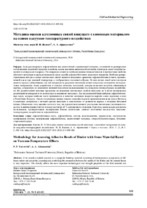Методика оценки адгезионных связей вяжущего с каменным материалом на основе вакуумно-температурного воздействия

Date
2024Publisher
Another Title
Methodology for Assessing Adhesive Bonds of Binder with Stone Material Based on Vacuum-Temperature Effects
Bibliographic entry
Яцевич, П. П. Методика оценки адгезионных связей вяжущего с каменным материалом на основе вакуумно-температурного воздействия = Methodology for Assessing Adhesive Bonds of Binder with Stone Material Based on Vacuum-Temperature Effects / П. П. Яцевич, А. А. Афанасенко // Наука и техника. – 2024. – № 5. – С. 409-416.
Abstract
Если рассматривать асфальтобетон как композитный строительный материал, состоящий из разнородных составляющих различной природы и свойств, весьма важными являются обеспечение и контроль связи матрицы вяжущего и минерального каркаса. Это напрямую влияет на наиболее важные технологические и прочностные свойства итогового материала и продолжительность срока службы асфальтобетонного дорожного покрытия. Наиболее распространенным методом оценки адгезионных связей является визуальное сравнение асфальтобетонной смеси, прокипяченной в воде при заданной температуре, с изображением эталонного образца. На наш взгляд, такой метод контроля является весьма субъективным, так как напрямую на результат испытания влияет визуальное восприятие исследователем изображения. Нами разработана и описана методика испытаний, которая позволяет получить объективную картину, основанную на изменении значений показателя водонасыщения под вакуумно-температурным воздействием. По разработанной методике проведены исследования адгезионных свойств вяжущего до и после модификации различными полимерами и их компаундов к каменному материалу. Для исследований были выбраны асфальтобетонные смеси, которые наиболее часто применяются в качестве материала покрытия верхних слоев дорожных одежд в Республике Беларусь. Анализ полученных данных показал зависимость риска проникновения воды между битумом и каменным материалом с потерей адгезии вяжущего к заполнителю от развитости каркаса и толщины битумной пленки. Объяснение этого явления состоит в том, что процент когезионного расслоения значительно увеличивается с ростом толщины пленки битума и может достигать 65 % когезионного отслоения. При этом, как показали результаты исследования, предварительная модификация битума значительно снижает негативные последствия вакуумно-температурного воздействия на асфальтобетон.
Abstract in another language
If we consider asphalt concrete as a composite building material, consisting of heterogeneous components of different nature and properties, ensuring and controlling the connection between the matrix of the binder and the mineral frame is very important. This directly affects the most important technological and strength properties of the final material and the service life of the asphalt concrete road surface. The most common method for assessing adhesive bonds is a visual comparison of an asphalt concrete mixture boiled in water at a given temperature with an image of a reference sample. In our opinion, this control method is very subjective, since the test result is directly influenced by the researcher’s visual perception of the image. We have developed and described a test method that allows us to obtain an objective picture based on changes in the values of the water saturation index under vacuum-temperature influence. Using the developed methodology, studies were carried out on the adhesive properties of the binder before and after modification with various polymers and their compounds to stone material. For the research, asphalt concrete mixtures were selected, which are most often used as a coating material for the top layers of road pavements in the Republic of Belarus. Analysis of the data obtained showed the dependence of the risk of water penetration between bitumen and stone material with loss of adhesion of the binder to the aggregate on the development of the frame and the thickness of the bitumen film. The explanation for this phenomenon is that the percentage of cohesive delamination increases significantly with increasing bitumen film thickness and can reach 65% of cohesive delamination. At the same time, as the results of the study showed, preliminary modification of bitumen significantly reduces the negative consequences of vacuum-temperature effects on asphalt concrete.
View/
Collections
- № 5[9]
